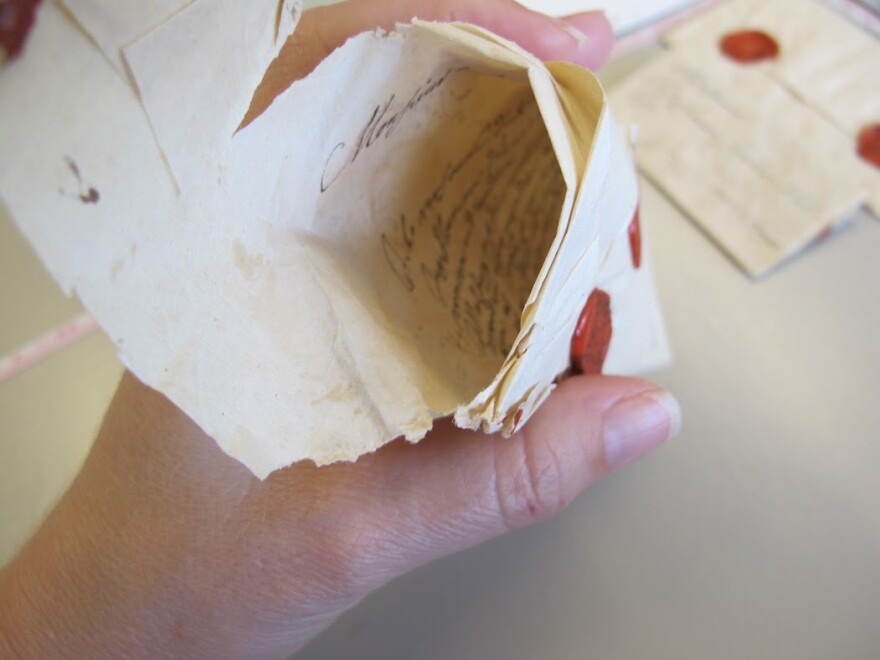A cask of letters was found in a museum in The Hague preserved by a 17th century postmaster in the Netherlands.
Deadbeat husbands, horrible bosses, and unplanned pregnancies are just a few of the topics written about in a recently-rediscovered chest found in the Netherlands containing hundreds of late-17th century letters.
A researcher at Yale is examining this "postal treasure trove," which is packed with all sorts of historical artifacts.
Before we hear about how scholars stumbled upon a case filled with 2,600 letters that are over 300 years old, let's look inside one letter, written by a woman to her husband. As Rebekah Ahrendt, of Yale University explains, the husband was a dancing master, and the woman was fed up with him, because, apparently his business wasn't so good, but he kept writing her, asking for money.
"She signs off her letter," Ahrendt said, "by saying, 'It is not for you to ask for anything. Enfin, my dear husband, despite all your faults, I am nevertheless, with respect, your very affectionate wife, Jean Le Cloutier.'"
"She actually crosses out the word wife," Ahrendt said. "She says I am your very affectionate 'wife,' no longer. And then closes by saying: 'I wish you better health than that which you intend for me. I am very well disposed.'"
That letter, along with hundreds more, are part of a project called Signed, Sealed, and Undelivered. It's a collaboration of historians, a cryptographer, and other academics from the U.S. and abroad who are examining a cask of letters found in a museum in The Hague preserved by a 17th century postmaster in the Netherlands named Simon de Brienne.
The chest contains hundreds more uncensored experiences of everyday life.
Brienne and his postal team, which included his wife, managed all the mail to and from France, the southern Netherlands, Spain, and portions of Italy. Lots and lots of mail.
Ahrendtsaid Brienne was "neurotic" in his record keeping. Undelivered letters were marked with a specific reason why they didn't reach their destination, like, someone refused delivery -- or died.
But Brienne didn't throw these letters out. He held onto them in the hopes that one day, someone would eventually show up and pay him for keeping the letters around.
"You have letters from nobility, from ambassadors, but also from people who were illiterate and had to actually hire letter writers," Ahrendt said. "Normally history is written from the records of elites, or from printed sources, which had their own particular audience, but in this case we have completely unedited, uncensored experiences of everyday life at the time."
Ahrendt, who studies music history at Yale, said she's particularly interested in another rare correspondence from the time, letters between musicians and actors.
Take a listen to this one below, which is a correspondence between a bass player and a violinist in The Hague, Netherlands:
The chest contains hundreds more uncensored experiences of everyday life. Ahrendt said the collection is a remarkable window into the history of language. Most of the letters were written in French, spelled phonetically using lots of local dialects, "but there are also letters in Dutch,"she said. "There are letters in Danish. There are letters in Italian, in Latin, and in Spanish."
The physical paper tells another story, particularly when it comes to how letters were packaged for shipping. "For the most part, especially because paper was very expensive at the time, you would take your sheet of paper and you would very carefully fold it so that it could become its own sending device," Ahrent said.
It's an art that's been dubbed "letterlocking," and some of these "locks" are extremely elaborate, featuring multiple seals and slices of paper fed back through holes cut into the mailing to keep the letter secure.

"We have found already about 30 some ways of folding letters in this collection, which demonstrate the extent to which people found privacy important," Ahrendt said.
Historians also just don't have a lot of these "locked" letters in their natural state, Ahrendt said, because, for ages, historians would always open letters, unfold them and put them into books.

For the 600-or-so letters that remain unopened in the chest of Simone de Brienne, there are no plans to physically open them up. Instead, historians will turn to science, using a technique called X-Ray microtomography. That's because the ink used in the letters contains iron, which shows up in X-Rays.
The Signed, Sealed, and Undelivered team also plans to scan the letters, so they're digitally available to the public. Ahrendt said in the meantime, she has years and years of letters to pore through. "Really great stories," she said, that will broaden our view of what it was like to live as an everyday person 300 years ago.







